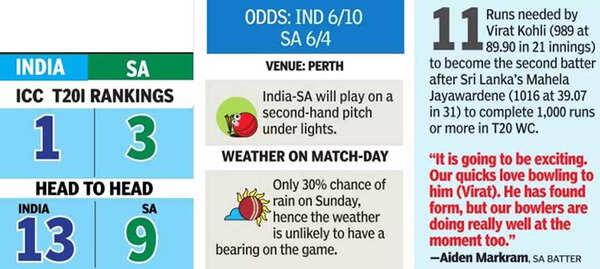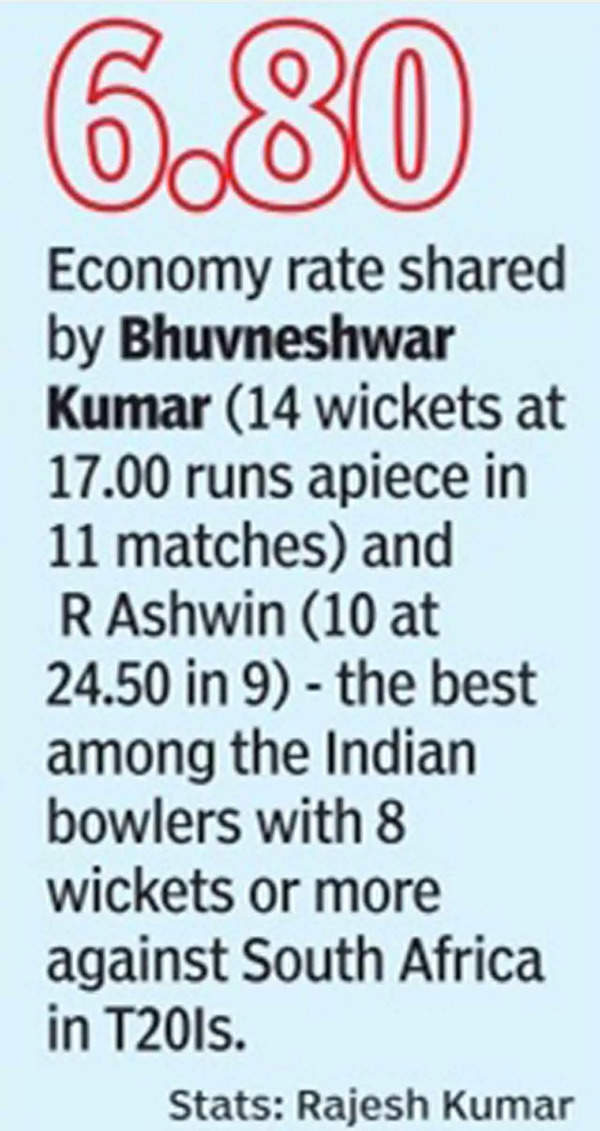PERTH: It is unusually cold here for late October. Perth is famous for the Freemantle Doctor, the cooling afternoon sea breeze which is strongest in December and January and likes to influence Test-match sessions at the WACA (now known as the Optus Stadium). On this day it’s a different wind, one with a serrated edge to it, which adds to the chill factor and makes everyone rush for their hoodies.
It is late afternoon and already overcast and drizzling when Rahul Dravid walks up to the net bowlers. They have been bunched together for long, whispering among themselves, waiting for India’s cricketers to arrive.
“What’ve we got here, boys,” Dravid asks with a smile. “Pace, sir,” says one, rubbing his hands nervously. “Pace like fire, eh,” says Dravid. He walks away with a nod and laugh, knowing what awaits Rohit Sharma‘s men here against South Africa here on Sunday.

From the outside, the Optus Stadium is shaped like a huge luxury ocean liner, just way, way bigger. Once inside, it is a concrete colosseum similar to the Melbourne Cricket Ground, with similarly big square boundaries. Also comparable is the pace and bounce on offer, although India’s batting coach Vikram Rathore said he believed the ball would come on to the bat a bit better compared to the MCG.
“It seems to be a good wicket,” said Rathour. “Melbourne was tough, but this looks better, more even paced and (with) more even bounce.”

South Africa are better placed to exploit the steep bounce, of course, with a multiple choice of hot pace options at their disposal, but they also have more at stake in this crunch game. Having lost a point against Zimbabwe due to the rain, and with a game coming up against Pakistan, a win here against India will give them some breathing space. India have begun well but could do with two more wins if they want to top the group comfortably. Pakistan, who play the first match of the day here against the Netherlands, will also be rooting for an India win since it enhances whatever chances they have left of qualification.
And that is what the tactics will boil down to: the second game of a double header usually sees a slightly worn-down pitch, so in spite of the bounce, will the team winning the toss be tempted to bat first like at the much slower SCG?

India’s bowling coach Paras Mhambrey had earlier insisted that India would not tinker with a winning XI under any circumstances, so left-arm spinner Axar Patel may be retained even though the match-ups are against him. “We already have four seamers (in Bhuvi, Arshdeep, Shami and Pandya), so nothing changes, at least for us,” said Rathore.
South Africa played both left-arm spinners, Keshav Maharaj and Tabraiz Shamsi, against Bangladesh at the SCG but Shamsi may have to make way here for a pacer: will it be the left-arm fast of Marco Jansen or Lungi Ngidi instead?
A triple-header will shake up the #T20WorldCup standings today, but which teams will push closer to a semi-final be… https://t.co/1TgpXKM0Xs
— T20 World Cup (@T20WorldCup) 1667093923000
In spite of all the talk about pace, there are two other factors that may prove significant in the game: SA are packed with in-form left-handers capable of striking at 160-plus, making offie Ashwin’s presence a crucial one in a double header. The other is that it is the top-order performance of the two sides that may well decide the game, not the form of the pacers.
India will also find out here if they will miss the out-and-out pace of Jasprit Bumrah. The pacers may also have to alter their lengths, apart from the naturally hit-the-deck Pandya, in order to be effective here.
Both sides have already played eight T20Is this year, although in vastly different conditions, with India winning four of those. Perth might be a different ball game, with a lot more at stake, but these two sides are so familiar with each other there is little room for surprise manoeuvres on either side.

